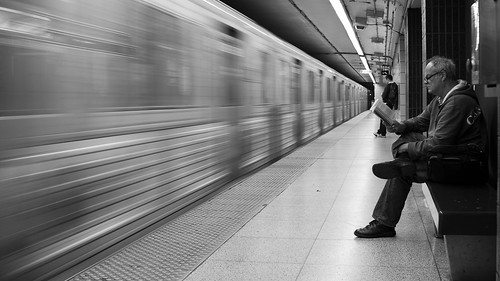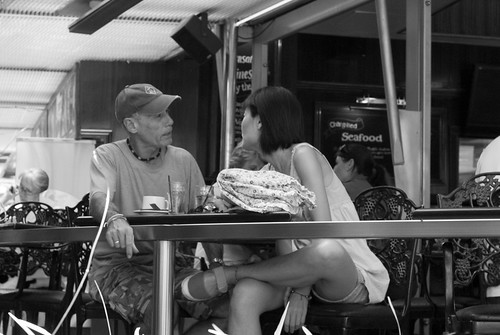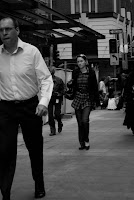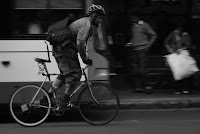I haven’t been out shooting any street over the last little while, so instead of giving you my tips and tricks, I will share some I have found on the web. Hopefully they will help me out, and you too.
Street Photography Series
- Previous Attempts
- Zone Focusing
- Hyperfocal Distance
- Progress?
- Tips and Tricks from the Web
19 Killer Street Photography Tips
The first site with some notable tips I have found is this one. From ILovePhotoBlogs.com. Here are the points that stood out to me.
What is the best lens for street photography?
“I personally like to use a wide lens (24mm, 28mm, 35mm on full frame 35mm) to be pretty close to my subject and get that intimate look of my photos. It took me a while to get closer, so I’d suggest to start with maybe a 75mm or 50mm lens to keep some distance and get closer from there…”
Lens choice is an important technical aspect to street photography, and this tip is something I have seen mentioned more than once (many times in fact).
What are the best places to shoot street photography?
“At a fair, a midway at a carnival, a sports event, parade, concert or public ceremony, people’s need for personal space and therefore privacy is reduced. The level of sensory stimulation is also usually high at these events, which tends to reduce the need for space. As well, in most of these situations people are having fun so they are more relaxed.”
Choosing somewhere to take street shots is important. You won’t get yourself out the door if you don’t have somewhere to go in mind.
10 Quick Street Photography Tips
This 2nd link is from a Canon Powershot S90 Street Photography Challenge website. It is just 10 short tips on how to get some street shots. I don’t necessarily agree with them all by the way. These are the tips that hit home when I read it.
3. PRE-FRAME. PRE-FOCUS.
Frame the scene, preset your focus and wait patiently for the right elements to fall into place, before you click. You’ll be surprised at the results of this simple technique.
This is another technique I have seen mentioned a few times. I have tried this out once or twice. If you see a great background or scene, and can imagine a person with a certain look would work well there, then frame up, and wait patiently for someone matching your idea to come by, or you might find someone with a different look that works while you are waiting.
5. SHOOT FROM THE HIP.Learn to frame your images without looking through the viewfinder or at the LCD. Shoot with the camera away from your face – from the hip or low at your chest work well. Low angle shooting also gives an interesting perspective.
Another way to get that candid shot. Most of the street photographers I follow have used this method from time to time. It is worth while learning to aim your camera without looking through the view finder. I am notoriously bad at this myself, but it is something I am working on.
6. OBSERVE. OBSERVE. OBSERVE.Keep your eyes open and be aware of your surroundings. Observe everyone and everything around you. You’ll be surprised at how much is going on in front of you, and how much you can anticipate – ready for that next perfect shot.
7. BE PATIENT.Street photography is a test of patience. Either waiting for the scene to evolve or just capturing the right shot, a great photograph takes time to realize. Don’t rush that special moment before clicking.
I believe these 2 tips go hand in hand. You must observe whats going on around you, and you must be patient. A good shot won’t come by every 10-15 seconds. Wait for it to make itself available, be prepared, anticipate it, and shoot it.
Street Photography Tips
This is the final link for todays post. There are some really great street shots posted in this forum post, along with some interesting tips.
readiness
learn your camera’s controls, shoot in a way that let’s you shoot quickly! i’m always pre-set for the most part (choice of iso, aperture) and i typically shoot in aperture priority mode. i also learn the hyperfocal distances of my lenses, so that i can shoot comfortable within a distance range. watch the lighting, which can change by 8 or 9 stops just by turning a corner! it’s really important to have all your senses focused on the job at hand
You must be able to react quickly, part of that is knowing that your equipment is ready, the other part is being ready to react yourself.
confidence
street shooting requires confidence.. *you* are doing nothing wrong, so don’t sneak around! put away that tele, and stick a fifty or thirty-five on your dslr, or set your digicam’s zoom to the wider end of things, and see the scene “normally,” up close and personaly. this may be strange for some of you, but i assure you it gets easier after your initial trepidation wears off. the worst that can happen is people say “no, i don’t want my photo taken,” and so you smile and move on! the wider angles offer so much more to the viewer imo, that they’re worth the extra effort in becoming more comfortable …
The final tip of the day is this one. BE CONFIDENT! This is something I definately suffer from myself, I am shy by nature, so being out in the middle of a group of strangers pointing my camera at them is not comfortable for me, but, I do get out there, and I do try it. The more you do it, the more confident you will get.
If you have any good tips please share them with me, ill make sure they get posted up. Best of luck with your street shooting







